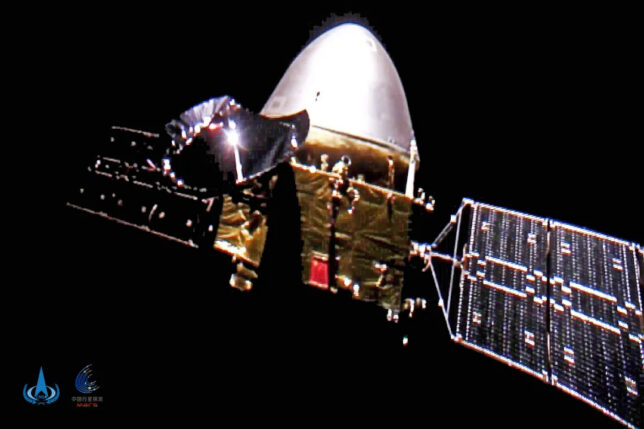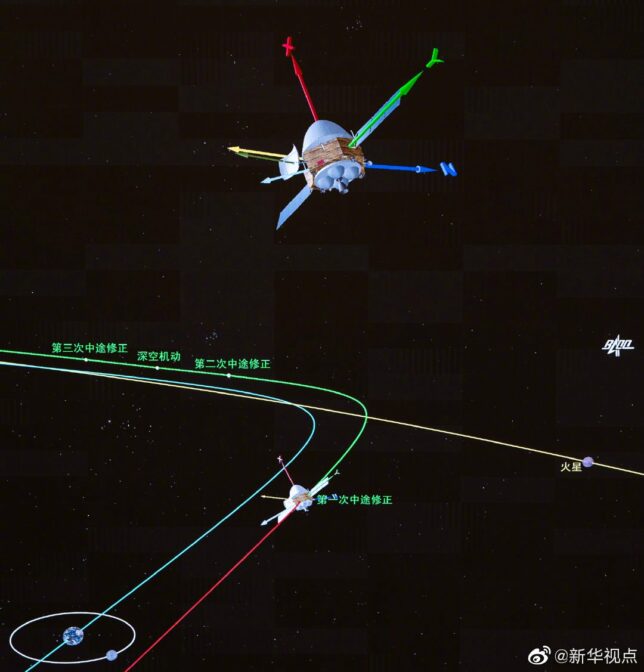Today, the Chinese National Space Agency and the Chinese Lunar Exploration Program have released some “selfies” taken by Tianwen-1 to celebrate China’s National Day. Apparently, the images have appeared originally in this press release (Google translation), and many media in English have echoed the news.
The best image can be seen below. This kind of image might show us something about Tianwen-1’s attitude, or maybe not? Let’s try to find out.

The method by which these images have been taken is quite interesting. A disposable camera that communicates wirelessly with the spacecraft was ejected and took one image per second until it was lost in the vastness of space. According to Wikipedia, this is not the first time something like this has been done: JAXA did it with the IKAROS spacecraft. In any case, it’s an uncommon and clever method. Usually a camera on a telescopic boom is used to do these selfies.
By the looks of the image, the Sun is behind the camera, and a bit towards the upper left side, judging by where the shadow of the high-gain antenna lies. The astute reader might come up with a more precise estimate by using the location where the sun reflects on the surface of the high-gain antenna dish. The solar panels seem to be oriented orthogonal to the Sun to maximize power.
We don’t know when this image was taken, but it’s not very important. The nominal attitude of Tianwen-1 with respect to the Sun hasn’t changed since the beginning of August. According to the quaternion data on the ADCS telemetry, the spacecraft maintains an angle of 20 degrees between the X axis and the Sun.
The image below, which is taken from the graphics in the control room of Tianwen-1, shows that the X axis corresponds to the nose of the spacecraft. Therefore, we would expect the Sun to be almost in front of the spacecraft’s nose. This clearly doesn’t match what we see in the selfie.

I think there are two possible explanations:
- The spacecraft changed its attitude to take the selfie
- The X axis is not the nose of the spacecraft but the body face where the high-gain antenna is placed (which is labelled as -Z in the figure above)
The first explanation totally makes sense and I think is the more likely. To take a good selfie, we would want to launch the camera towards the Sun, so that the spacecraft is front lit. We would also like to orient the spacecraft more or less as in the selfie we’ve seen. I think this gives the most interesting view of the spacecraft, where most of its elements can be seen well. Since the selfie was already planned in the spacecraft design, as a camera specifically for this was included, I would expect all attention to detail in order to get the best image.
In fact, in the press release there is special attention given to the Chinese flag on the side of the spacecraft, so we can think that the selfie was planned so that the flag could be seen well. This requires front lighting and this kind of spacecraft orientation.
We haven’t seen telemetry indicating that Tianwen-1 performed this kind of attitude change to “pose” for the selfie. However, we don’t get telemetry when the spacecraft is not in view of Europe or when the signal is lost (which could happen as a result of an attitude change), so this doesn’t rule anything out.
The second explanation more or less matches the Sun location the selfie image. This wouldn’t imply that the picture from the control room is wrong. Sometimes, different subsystems label the spacecraft axes differently. However, I don’t think this explanation is possible. We’re sure that the Y axis is along the solar panels (because it is maintained orthogonal to the plane where the spacecraft, Sun and Earth lie), so the Z axis would be either the nose or the thruster of the spacecraft. We’ve seen an angle between the Earth and the -Z axis as low as 5 degrees, and I don’t think the high-gain antenna is able to slew so close to the nose or thruster.
Speaking of slewing the high-gain antenna, note that there is a cut-out in the dish so that it doesn’t collide with the dome where the lander is stored. This gives the antenna a much larger slew range than I expected and explains why the current angle between the -Z axis and the Earth can be more than 60 degrees.
So in summary, I don’t think this selfie image tells us anything new about the nominal attitude, since it seems that the spacecraft was carefully oriented for taking the best selfie. In any case, it’s interesting to think what kind of things can be guessed from these images.
Congratulations to CNSA and CLEP for inspiring a whole nation about space exploration. Enjoy the festivities! (since this year National Day and the Mid-Autumn festival happen the same day).
The bottom left corner of the photo says “China Planetary Exploration – Mars”. New program.
Thanks for the information! I heard somewhere that Tianwen-1 was managed by the Lunar Exploration program, since the Planetary Exploration program was on the process of being created, and the article I used as reference mentioned CLEP instead of CPEP..